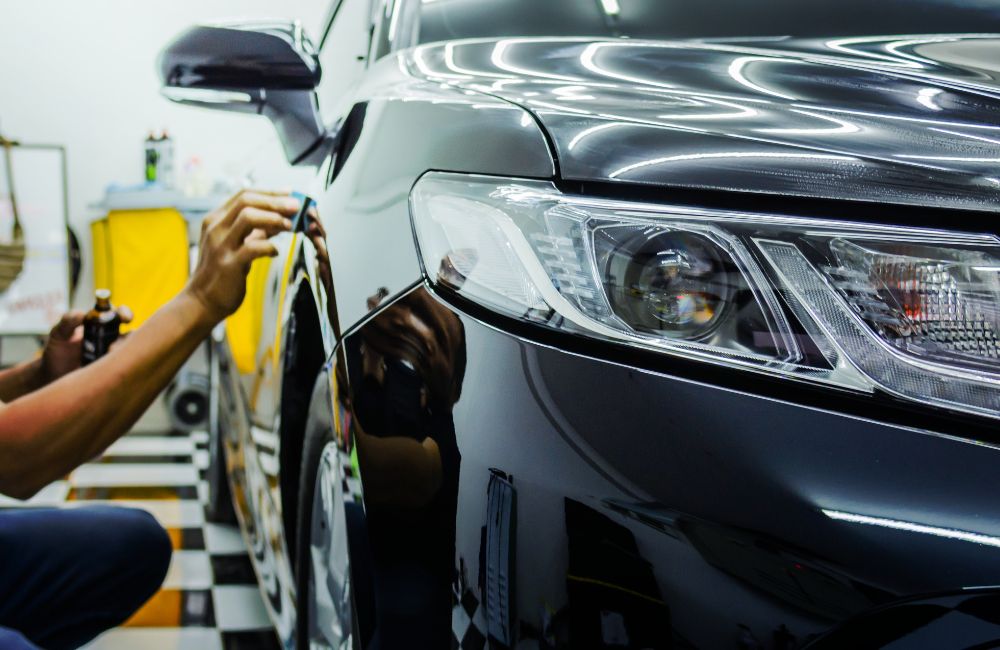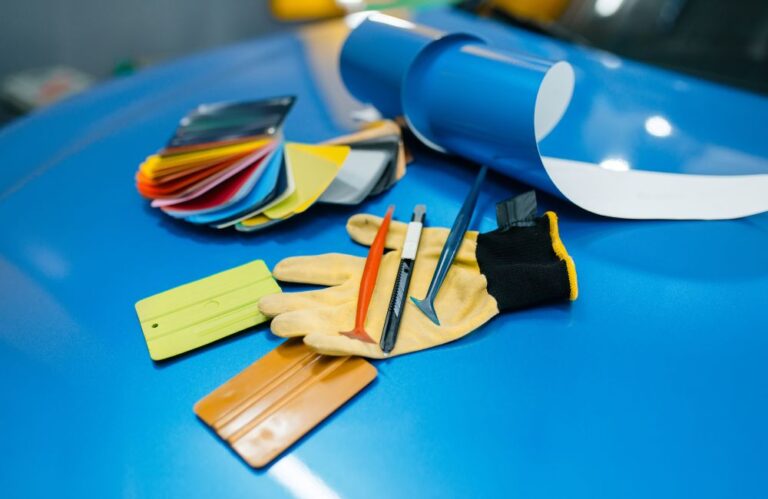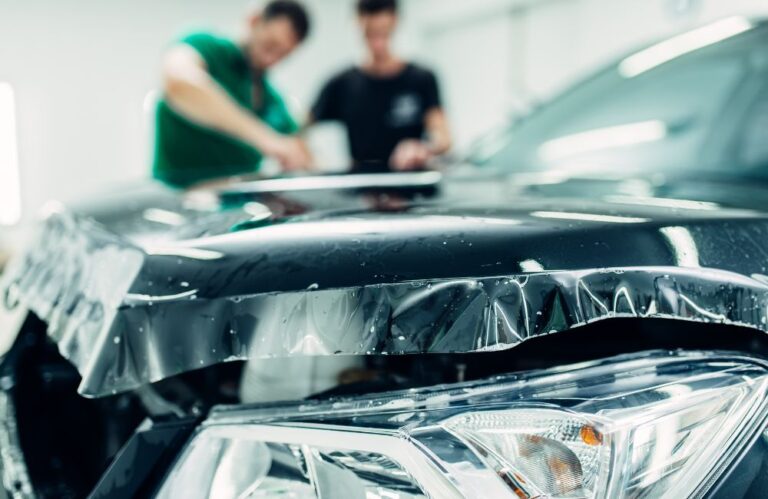Vehicle ceramic coating in New York offers unparalleled protection and shine for your car, making it a popular choice among vehicle enthusiasts seeking to preserve their car’s appearance and durability. However, the process involves precision and knowledge to avoid common pitfalls that can compromise the coating’s effectiveness. Ensuring your vehicle’s ceramic coating is applied correctly is crucial for long-term satisfaction.
Table of Contents
Introduction
Key Takeaways
Mistake #1: Poor Surface Preparation
Mistake #2: Incorrect Application Methods
Mistake #3: Using Low-Quality Coatings
Mistake #4: Overlooking Curing Times
Mistake #5: Neglecting Maintenance Post-Application
Mistake #6: Applying Too Many Layers
Mistake #7: Ignoring Manufacturer’s Instructions
Mistake #8: DIY Without Proper Knowledge or Experience
Frequently Asked Questions (FAQs)
Key Takeaways ✔ Inadequate cleaning and decontamination before applying a ceramic coating can prevent proper adhesion, compromising the coating’s effectiveness and durability. ✔ Failing to apply ceramic coating correctly can lead to uneven coverage, reducing the coating’s aesthetic appeal and protective qualities. ✔ Opting for cheaper, lower-quality ceramic coatings can result in a less durable finish that offers inferior protection and requires more frequent reapplication. ✔ Ignoring the recommended curing times compromises the coating’s hardness and protective capabilities, making it less effective against environmental hazards. ✔ Ceramic coatings demand regular maintenance to retain their hydrophobic properties and protective performance, contrary to the belief that they are maintenance-free. ✔ Excessive layering of the ceramic coating does not equate to increased protection but can lead to issues such as reduced clarity and difficulty in maintenance. ✔ Overlooking the specific application and care instructions the coating manufacturer provides can lead to suboptimal results and potential product failure. ✔ Attempting to apply ceramic coating without the necessary expertise can result in a flawed finish that fails to protect adequately, often requiring costly professional correction. |
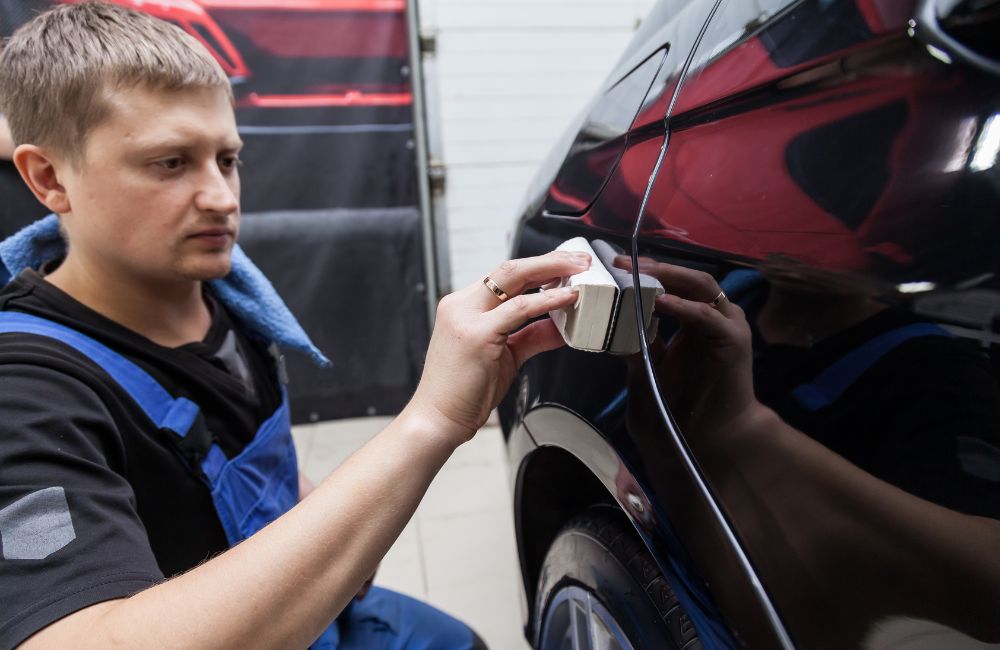
Mistake #1: Poor Surface Preparation
Before applying a vehicle ceramic coating, the vehicle’s surface must be prepared meticulously. This preparation is crucial for the coating to properly adhere to the vehicle’s paint, ensuring longevity and effectiveness. Improper surface preparation can lead to many issues, including premature peeling, reduced shine, and an ineffective coating.
Cleaning and Decontamination
- Thorough Washing: Begin with a detailed wash using a high-quality, pH-neutral car shampoo. This step removes surface dirt and grime, preparing the vehicle for deeper decontamination.
- Chemical Decontamination: Apply a chemical decontaminator to remove iron particles and other contaminants that a regular wash cannot. This step is crucial for preventing contaminants from interfering with the vehicle ceramic coating’s bonding process.
- Clay Bar Treatment: A clay bar is gently glided across the paint to pick up embedded contaminants like tar, sap, and fallout. This mechanical decontamination ensures a surface as smooth as glass, a critical factor for a flawless coating application.
- Drying: After decontamination, the vehicle must be thoroughly dried using microfiber towels or a blower to prevent water spots, which could affect the coating’s adherence.
- Surface Inspection: Conduct a final inspection of the vehicle’s surface using adequate lighting to ensure all contaminants are removed. Any overlooked imperfections can hinder the ceramic coating’s performance.
Paint Correction
- Scratch and Swirl Removal: Use a dual-action polisher and appropriate polishing compounds to remove any scratches, swirl marks, or oxidation from the paint. This step is essential, as the vehicle ceramic coating will lock in the paint’s current state.
- Fine Polishing: After correcting major imperfections, a finer polish is applied to enhance the paint’s gloss. This ensures the vehicle’s ceramic coating will reflect light uniformly, maximizing the vehicle’s shine.
- Panel Wipe: Use a panel wipe solution to remove any oils or residues left from the polishing process. This step ensures that the ceramic coating bonds properly to the vehicle’s paint.
- Masking Off: Before applying the ceramic coating, it’s important to tape off any plastic trim, rubber seals, and sensitive areas. This prevents the coating from adhering to these surfaces, where it can create a white residue that’s difficult to remove.
- Environment Check: Ensure the environment is suitable for application—ideally indoors with controlled temperature and humidity. Dust, pollen, and fluctuating temperatures can compromise the quality of the ceramic coating application.
Mistake #2: Incorrect Application Methods
A vehicle ceramic coating requires precision, patience, and attention to detail. Incorrect application methods can lead to uneven coverage, streaking, and a compromised protective layer. To ensure the ceramic coating fulfills its promise of protecting and enhancing your vehicle’s exterior, let’s explore two critical subsections of the application process, each outlining five essential points.
Proper Application Techniques
- Correct Product Application: Apply the ceramic coating product in small sections, working systematically across the vehicle’s surface. This ensures even coverage and prevents the product from drying too quickly, which can cause streaks.
- Utilizing the Right Tools: Apply the ceramic coating using a high-quality microfiber applicator pad. The right tool facilitates an even application and minimizes the risk of introducing contaminants to the coating.
- Cross-Hatch Method: Employ a cross-hatch technique by applying the coating in overlapping horizontal and then vertical strokes. This method ensures comprehensive coverage and helps avoid missed spots or uneven thickness.
- Layering: If the product recommends multiple layers, allow the first layer to cure properly before applying the next. This step is crucial for building a durable protective barrier without compromising the finish.
- Lighting and Inspection: Use adequate lighting to inspect the application as you work. This helps identify areas needing correction or additional product, ensuring a uniform coat across the vehicle.
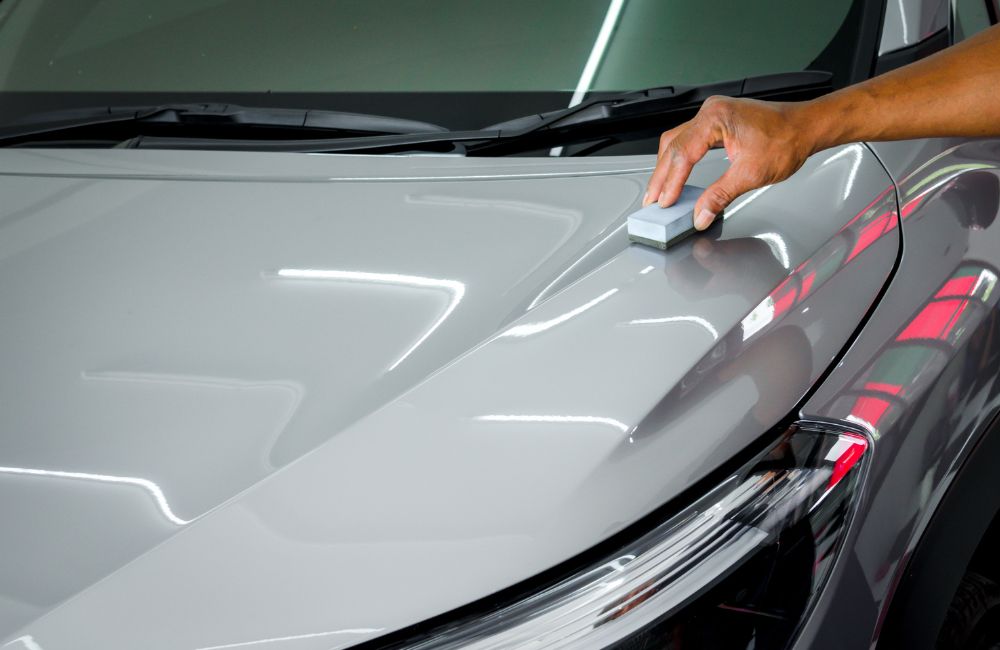
Mistake #3: Using Low-Quality Coatings
Saving on costs can lead many to choose lower-priced vehicle ceramic coatings in New York. Still, this decision often results in a less-than-satisfactory finish and protection that falls short of expectations. Understanding the pitfalls of low-quality coatings and the benefits of investing in high-grade products is key to achieving a long-lasting, durable finish that truly preserves your vehicle’s appearance.
Drawbacks of Low-Quality Coatings
- Reduced Lifespan: Lower-quality vehicle ceramic coatings may not offer the same longevity as their higher-quality counterparts, necessitating more frequent applications and ultimately leading to higher long-term costs.
- Inferior Protection: The primary purpose of a vehicle ceramic coating is to provide a strong layer of protection against environmental contaminants, UV rays, and minor abrasions. Low-quality coatings may fail to provide this level of protection, leaving your vehicle vulnerable to damage and deterioration.
- Poor Finish: A flawless, glossy finish is a hallmark of high-quality vehicle ceramic coating. Low-grade products often result in a finish that lacks depth, clarity, and the sought-after “wet look” that enhances your vehicle’s aesthetic appeal.
- Complex Application: High-quality coatings are formulated for ease of application and forgiving properties that allow for correction during the process. Low-quality options may be more challenging to apply evenly, leading to streaks, bubbles, and an unprofessional appearance.
- Lack of Warranty or Support: With cars, manufacturers often offer warranties for a specific period. The same goes for ceramic coating – premium vehicle ceramic coatings often come with the assurance of a warranty and customer support. Lower-quality products typically offer limited to no support, leaving you alone if issues arise.
Mistake #4: Overlooking Curing Times
Curing times can vary significantly between different vehicle ceramic coatings, influenced by factors such as the specific formulation of the product, ambient temperature, and humidity levels. Adhering to the recommended curing times is vital for ensuring the coating achieves its full protective capabilities and aesthetic qualities.
Why Adhering to Curing Times Matter
- Achieving Full Hardness: During the curing process, vehicle ceramic coatings undergo a chemical reaction that transforms them from a liquid to a solid state. This transition is crucial for the coating to achieve its maximum hardness and protective properties.
- Ensuring Proper Bonding: Curing time also allows the coating to bond properly with the paint, creating a seamless protective layer. Overlooking curing times can result in weak bonding, making the coating more susceptible to peeling and wear.
- Maximizing Durability: A fully cured vehicle ceramic coating offers enhanced durability and is capable of withstanding environmental aggressors like acid rain, bird droppings, and UV rays more effectively than a coating that hasn’t been allowed to cure properly.
- Enhancing Aesthetic Appeal: The curing process also plays a role in developing the coating’s final appearance. A properly cured coating will exhibit superior gloss and depth, enhancing the vehicle’s overall aesthetic appeal.
- Warranty Considerations: Many vehicle ceramic coatings come with warranties that are contingent on following the recommended application and curing procedures. Failure to adhere to these guidelines may void the warranty, leaving you without recourse in the event of a product failure.
Mistake #5: Neglecting Maintenance Post-Application
A vehicle ceramic coating acts as a robust protective layer for your car’s paint, but like any protective measure, it requires regular upkeep to maintain its integrity. Follow essential maintenance practices to keep your ceramic coating performing at its best.
Routine Cleaning Practices
- Regular Washing: In addition to washing your car every other week, it’s best to wash it with a pH-neutral shampoo designed for ceramic-coated vehicles. This removes harmful contaminants before they can bond to the coating, preserving its hydrophobic properties.
- Avoid Harsh Chemicals: Strong detergents and harsh chemicals can degrade the vehicle ceramic coating over time. Always opt for gentle, automotive-specific cleaners that are safe for ceramic coatings.
- Soft Washing Tools: Use soft, microfiber mitts and towels during washing and drying to prevent swirl marks and scratches on the coating. The gentle action of these tools helps maintain the coating’s integrity.
- Dry Properly: Avoid air drying to prevent water spots which can etch into the coating. Instead, use a clean microfiber towel or a blower designed for automotive use to dry your vehicle thoroughly.
- Spot Cleaning: Immediately clean bird droppings, tree sap, and other aggressive contaminants as they occur. These substances can etch into the coating if left untreated, diminishing its appearance and protective qualities.
Mistake #6: Applying Too Many Layers
Applying the correct number of layers for a vehicle ceramic coating is a balance between achieving optimal protection and maintaining the integrity of the coating. Exceeding this balance can result in diminished returns and potential problems.
Consequences of Excessive Layering
- Reduced Clarity and Gloss: While vehicle ceramic coatings are designed to enhance the paint’s gloss and clarity, applying too many layers can lead to a cloudy or milky appearance, detracting from the vehicle’s aesthetic.
- Difficulty in Application and Removal: Each additional layer of ceramic coating requires precision in application and increases the complexity of the process. Removing or correcting overly layered coatings can be labor-intensive and costly.
- Increased Risk of Peeling and Flaking: Excessive layers can compromise the flexibility of the ceramic coating, leading to a higher risk of peeling and flaking over time as the layers cannot properly bond with each other or the paint surface.
- Wastage of Product: Overapplication leads to unnecessary wastage of the ceramic coating product. Considering the cost of high-quality coatings, this can significantly increase the overall expense of the detailing process without providing additional benefits.
- Longer Curing Times: Additional layers require longer overall curing times. This not only delays the time until the vehicle can be fully utilized but can also introduce complications if the coating is not allowed to cure properly between layers.
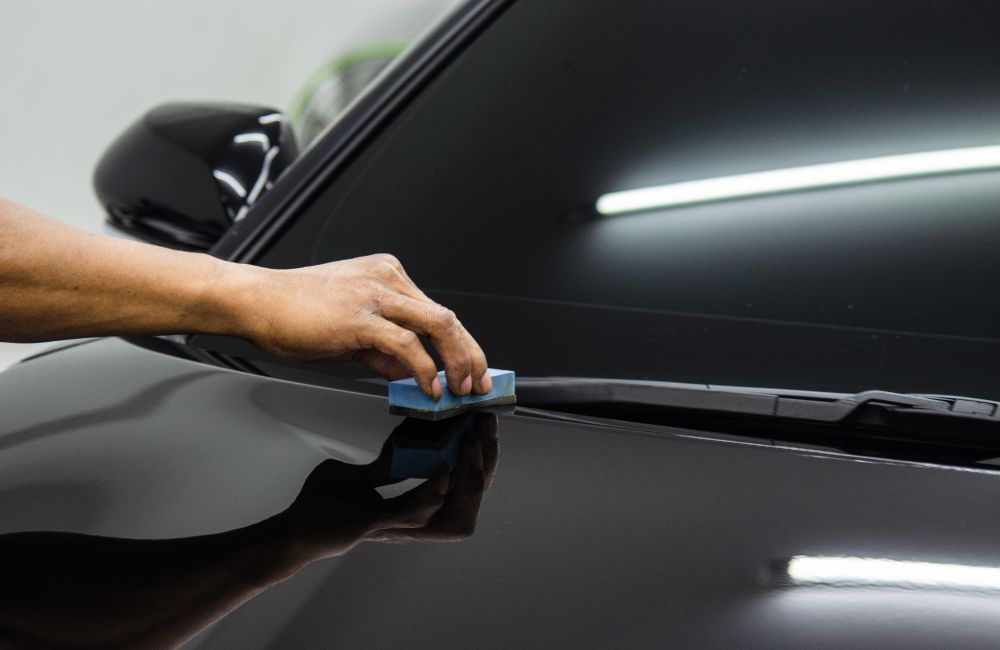
Mistake #7: Ignoring Manufacturer’s Instructions
Adhering strictly to the manufacturer’s instructions ensures that the vehicle ceramic coating bonds correctly to the vehicle’s surface, providing the promised level of protection and shine. Ignoring these directives can undermine the coating’s performance and longevity.
Consequences of Disregarding Instructions
- Compromised Bonding: Ceramic coatings need to bond properly with the paint surface to provide effective protection. Failure to follow application instructions can result in poor adhesion, leading to peeling or flaking of the coating.
- Uneven Finish: Manufacturer guidelines often include specific instructions for application techniques to ensure an even and smooth finish. Ignoring these can result in streaks, high spots, or an overall uneven coating that detracts from the vehicle’s appearance.
- Reduced Effectiveness: Each ceramic coating is formulated to offer certain protective qualities, such as UV resistance, hydrophobicity, and scratch resistance. Incorrect application or curing can diminish these properties, leaving the vehicle inadequately protected.
- Warranty Voidance: Many vehicle ceramic coatings come with warranties that are contingent upon following the specified application and maintenance procedures. Deviating from these instructions can void the warranty, leaving you without support if the product fails.
- Increased Costs: Correcting mistakes made by not following instructions often involves additional costs, including the purchase of more product or professional services to repair and reapply the coating correctly.
Mistake #8: DIY Without Proper Knowledge or Experience
Attempting to apply a vehicle ceramic coating without a thorough understanding of the process and the product can result in numerous issues, undermining the coating’s effectiveness and potentially harming your vehicle’s exterior.
Challenges of DIY Application
- Inadequate Surface Preparation: Properly preparing the vehicle’s surface is crucial for the ceramic coating to bond correctly. Without the right tools and techniques, DIY enthusiasts might miss contaminants or fail to achieve the necessary paint correction, leading to a compromised foundation for the coating.
- Application Mistakes: Ceramic coatings require precise application techniques, including even layering and appropriate curing times. Novices often struggle with achieving a uniform coat, resulting in streaks, bubbles, or uneven thickness that detracts from the vehicle’s appearance and protection.
- Misjudging Product Quality: Without extensive knowledge, DIYers may choose lower-quality coatings, not understanding the trade-offs in terms of durability, protection, and finish. This can lead to a less effective coating that fails to live up to expectations.
- Curing Errors: The importance of proper curing conditions and times cannot be overstated. Amateurs might not have access to an ideal environment for curing, or they may rush the process, both of which can severely affect the coating’s performance and longevity.
- Cost of Correction: Mistakes made during DIY application can be costly to rectify. Professional removal and reapplication of the ceramic coating can significantly exceed the initial cost savings intended by opting for a DIY approach.
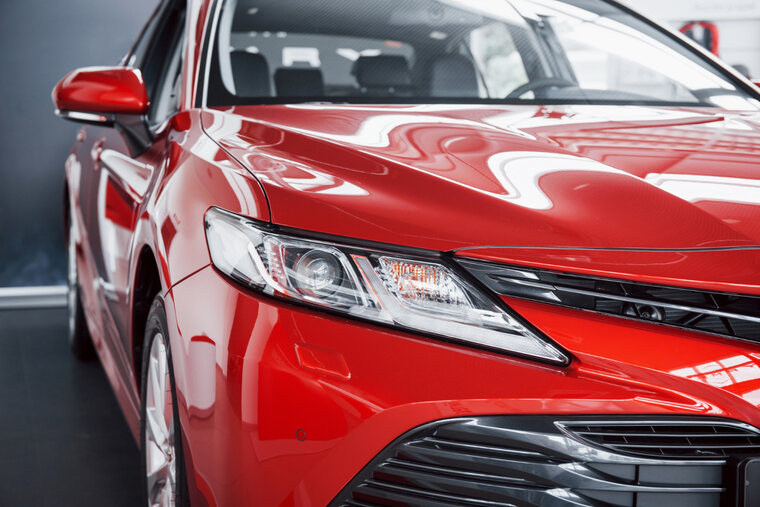
Frequently Asked Questions (FAQs)
Can I apply wax over my vehicle’s ceramic coating for extra shine and protection?
While a vehicle ceramic coating provides a high shine and protection level, applying wax is not recommended. Ceramic coatings are designed to be the outermost layer of your vehicle’s paint, providing superior protection and hydrophobic properties. Adding wax on top of a ceramic coating can interfere with its ability to repel water and contaminants, diminishing the effectiveness of the coating.
How often should I reapply vehicle ceramic coating to maintain its effectiveness?
The lifespan of a vehicle ceramic coating depends on various factors, including the quality of the product, the environment, and how well the vehicle is maintained. Most high-quality ceramic coatings can last anywhere from 2 to 5 years or more before needing reapplication. To maintain its effectiveness, following the recommended maintenance routine, including regular washing with appropriate products, is crucial. Monitoring the coating’s performance over time will help you determine when it’s time for a new application.
Is it safe to take my ceramic-coated vehicle through an automatic car wash?
Automatic car washes, especially those with brushes, can be abrasive and may diminish the integrity of your vehicle’s ceramic coating over time. The harsh brushes and chemicals used in some automatic car washes can cause micro-scratches and degrade the coating’s hydrophobic properties. To maintain a ceramic-coated vehicle, it’s best to stick to hand washing with a pH-neutral shampoo and soft microfiber towels to avoid unnecessary wear on the coating.
Can vehicle ceramic coating be applied to wheels and glass?
Yes, vehicle ceramic coating can be applied to wheels and glass, offering the same level of protection and hydrophobic benefits as paint. Applying a ceramic coating to wheels can help protect against brake dust adhesion and make them easier to clean while coating on glass improves visibility during rain by repelling water.
What should I do if I notice a scratch on my ceramic-coated vehicle?
If you notice a scratch on your ceramic-coated vehicle, it’s essential to assess the depth of the scratch first. If the scratch is superficial and only affects the coating itself, a professional detailer may be able to repair it without needing to reapply the coating to the entire vehicle. For deeper scratches that penetrate through the coating to the paint, paint correction might be necessary before reapplying the ceramic coating to the affected area.
Unleash Your Vehicle’s True Potential with Car Wrap – Illmatic Wraps (NYC)
For those seeking unparalleled professionalism and quality in New York, Car Wrap – Illmatic Wraps (NYC) is the premier choice for your vehicle’s ceramic coating needs. With a team of experienced professionals specializing in the latest ceramic coating technologies, we ensure that every vehicle is treated with the utmost care, delivering a finish that protects and enhances your vehicle’s appearance. Reach out today to learn more!

